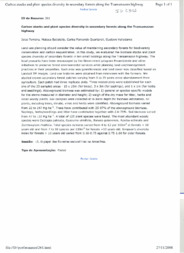Carbon stocks and plant species diversity in secondary forests along the Transamazon highway.
Carbon stocks and plant species diversity in secondary forests along the Transamazon highway.
Autoria: FERREIRA, J. N.; BATISTELLA, M.; QUARTAROLI, C. F.; VALLADARES, G. S.
Resumo: Land use planning should consider the value of maintaining secondary forests for biodiversity conservation and carbon sequestration. In this study, we evaluated the biomass stocks and plant species diversity of secondary forests in ten small holdings along the Transamazon highway. The local peasants have been encouraged by the Government program Proambiente and other initiatives to preserve forest environmental services while planning land use/management practices in their properties. Each area was georeferenced and land cover was classified based on Landsat TM images. Land use histories were obtained from interviews with the farmers. We studied eleven secondary forest patches varying from 5 to 25 years since abandonment from agriculture. Each patch had three replicate plots. Three nested plots were established for each one of the 33 sampled areas - 10 x 10m (for trees), 3 x 3m (for saplings), and 1 x 1m (for herbs and seedlings). Aboveground biomass was estimated by: 1) general or species-specific models for the stems measured in diameter and height; 2) weigh of the dry mass for litter, herbs and small woody plants. Soil samples were collected at 0-30cm depth for biomass estimation. All plants, including trees, shrubs, vines and herbs were identified. Aboveground biomass varied from 22 to 247 Mg ha-1. Trees have contributed with 25-97% of the aboveground biomass. Saplings, herbs/seedlings and litter have contributed together with 2.6-75%. Soil biomass varied from 47 to 132 Mg ha-1. A total of 125 plant species were found. The most abundant woody species were Cecropia palmata, Guazuma ulmifolia, Banara guianensis, Apeiba echinata and Zanthoxylum rhoifolia. Total species richness varied from 4 to 12 per 100m2 at forests < 10 years old and from 7 to 18 species per 100m2 for forests >10 years old. Simpson?s diversity index for forests > 10 years old varied from 0.18-0.75 against 0.75-1.00 for older forests.
Ano de publicação: 2008
Tipo de publicação: Resumo em anais e proceedings
Unidade: Embrapa Amazônia Oriental
Palavras-chave: Amazonia, Florestas secundárias
Observações
1 - Por padrão são exibidas publicações dos últimos 20 anos. Para encontrar publicações mais antigas, configure o filtro ano de publicação, colocando o ano a partir do qual você deseja encontrar publicações. O filtro está na coluna da esquerda na busca acima.
2 - Para ler algumas publicações da Embrapa (apenas as que estão em formato ePub), é necessário ter, no celular ou computador, um desses softwares gratuitos. Sistemas Android: Google Play Livros; IOS: iBooks; Windows e Linux: software Calibre.
Acesse outras publicações
Acesse a Base de Dados da Pesquisa Agropecuária (BDPA) para consultar o acervo completo das bibliotecas da Embrapa.

